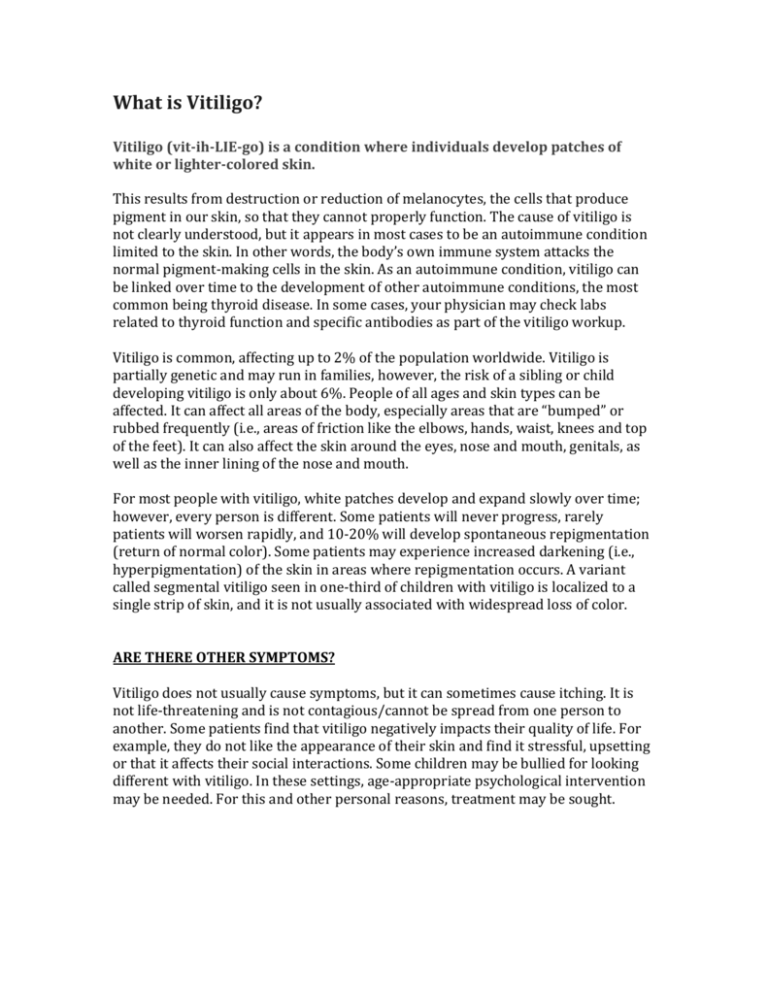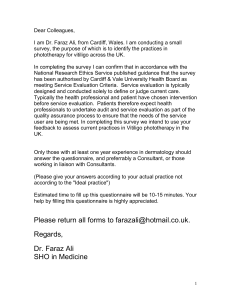Word version for EMR - Society for Pediatric Dermatology
advertisement

What is Vitiligo? Vitiligo (vit-ih-LIE-go) is a condition where individuals develop patches of white or lighter-colored skin. This results from destruction or reduction of melanocytes, the cells that produce pigment in our skin, so that they cannot properly function. The cause of vitiligo is not clearly understood, but it appears in most cases to be an autoimmune condition limited to the skin. In other words, the body’s own immune system attacks the normal pigment-making cells in the skin. As an autoimmune condition, vitiligo can be linked over time to the development of other autoimmune conditions, the most common being thyroid disease. In some cases, your physician may check labs related to thyroid function and specific antibodies as part of the vitiligo workup. Vitiligo is common, affecting up to 2% of the population worldwide. Vitiligo is partially genetic and may run in families, however, the risk of a sibling or child developing vitiligo is only about 6%. People of all ages and skin types can be affected. It can affect all areas of the body, especially areas that are “bumped” or rubbed frequently (i.e., areas of friction like the elbows, hands, waist, knees and top of the feet). It can also affect the skin around the eyes, nose and mouth, genitals, as well as the inner lining of the nose and mouth. For most people with vitiligo, white patches develop and expand slowly over time; however, every person is different. Some patients will never progress, rarely patients will worsen rapidly, and 10-20% will develop spontaneous repigmentation (return of normal color). Some patients may experience increased darkening (i.e., hyperpigmentation) of the skin in areas where repigmentation occurs. A variant called segmental vitiligo seen in one-third of children with vitiligo is localized to a single strip of skin, and it is not usually associated with widespread loss of color. ARE THERE OTHER SYMPTOMS? Vitiligo does not usually cause symptoms, but it can sometimes cause itching. It is not life-threatening and is not contagious/cannot be spread from one person to another. Some patients find that vitiligo negatively impacts their quality of life. For example, they do not like the appearance of their skin and find it stressful, upsetting or that it affects their social interactions. Some children may be bullied for looking different with vitiligo. In these settings, age-appropriate psychological intervention may be needed. For this and other personal reasons, treatment may be sought. TIP FOR MANAGING VITILIGO Avoiding tanning of normal skin can make areas of vitiligo less noticeable by decreasing the difference in color contrast between normal and affected skin. The white skin of vitiligo has far less natural protection from sun and can be very easily sunburned. Therefore, sunscreen (SPF 50 or more) should be used on all areas of vitiligo not covered by clothing. Disguising vitiligo with make-up or self-tanning compounds is a safe way to make it less noticeable. Waterproof cosmetics to match almost all skin colors are available at many large department stores. These products gradually wear off. Self-tanning compounds contain a chemical called dihydroxyacetone that does not need melanocytes to make the skin a tan color. The color from self-tanning creams also slowly wears off. None of these can change the actual disorder, but they can improve appearance. TREATMENT OPTIONS It is reasonable for an individual who is pale not to seek therapy, but rather to use consistent sun protection (sunscreen, clothing and sun avoidance) to prevent the vitiligo areas from becoming more noticeable when the normal skin around them tans. For those seeking treatment, the therapies below have been demonstrated to be effective in some individuals. Seeing a dermatologist to review these options for your child may aid in making the appropriate choice. TOPICAL THERAPY Creams containing corticosteroids or calcineurin inhibitors (an alternate form of anti-inflammatory medication) can be effective in returning pigment. These can be used along with other treatments. Corticosteroid creams can thin the skin or cause stretch marks, so they should be used under your dermatologist’s care. Special care should be taken when using corticosteroids around the eyes. LIGHT THERAPY (TYPICALLY NARROW BAND UVB) Controlled exposure to UVB light (narrowband UVB and 308-nm laser) can be beneficial. When access to these treatment devices is limited, natural sun exposure may be “prescribed” either alone or in conjunction with other therapies in order to help jump start the repigmentation process. As with any treatment, there are possible risks and side effects that can occur. The unaffected normal skin may darken with treatment, which can make the vitiligo patches more noticeable, and some patients may experience increased darkening (i.e., hyperpigmentation) in areas where repigmentation occurs. There may be a small increased risk of skin cancer with treatment, and the person being treated must be old enough to be able to keep his/her eyes shielded. Light treatment is usually done 2-3 times a week, for at least several months at a time. Please discuss the risks and benefits of this option with your physician if it is being considered. GRAFTING Transfer of skin from normal to white areas is a treatment available only in certain areas of the country. Contributing SPD Members: Tess Peters, MD, Ki-Young Yoo, MD Committee Reviewers: Brandi Kenner-Bell, MD, Andrew Krakowski, MD Expert Reviewer: Nanette Silverberg, MD The Society for Pediatric Dermatology and Wiley Publishing cannot be held responsible for any errors or for any consequences arising from the use of the information contained in this handout. Handout originally published in Pediatric Dermatology: Vol. 32, No. 6 (2015). © 2015 The Society for Pediatric Dermatology











